Flatworms are a group of very simple animals limited in size by a lack of an internal transport system, they can grow quite long though. The group contains many unpleasant internal parasites of almost every vertebrate species including man. They often alternate between host species as part of their life cycle which helps them spread more effectively.
Platyhelminthes - Flat Worms - Platy - flat, Helminth - worm
Typical Platyhelminths
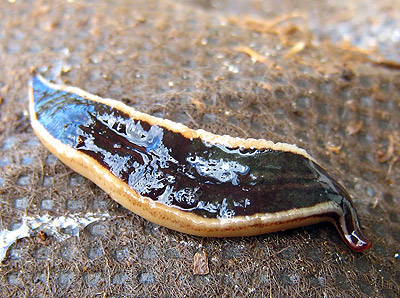
New Zealand flatworm,
Arthurdendyus triangulatus - Turbellaria
An invasive species in Europe that feeds almost
exclusively on earthworms.
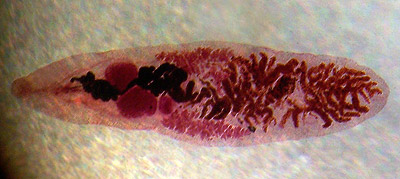
Lancet liver fluke,
Dicrocoelium
dendriticum - Trematoda
A
parasitic fluke of cattle,sheep and other grazing animals,
its intermediary hosts are a land snail and an ant,
rarely it may also infect humans. Infected ants at dusk
climb up a blade of grass to the tip where they hang
by their jaws, this makes them much more likely to be
eaten by the next host, the grazing vertebrate, if they
don't get eaten, they join the rest of the ants for
the rest of the day.
Cartoon of the lifecycle

Taenia solium, the pork
tapeworm - Cestoda
Scolex with
four suckers and two rows of hooks with which it attaches
to the intestine wall of its vertebrate host.

Taenia solium, the pork
tapeworm- Cestoda
Proglottids,
these develop away from the scolex maturing as they
move closer to the end when they are then shed with
their eggs.
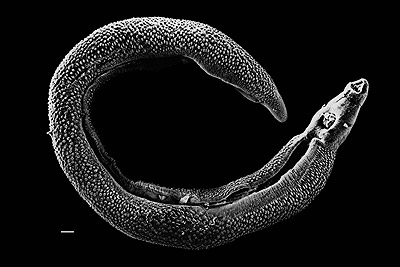
Adult male schistosome or blood
fluke - Tremotoda
The cause of schistosomiasis
or bilharzia, the second most common tropical infectious
disease after malaria. The white bar at bottom left
is 0.5mm long. There are estimated to be around 230
million people in 77 countries who are infected by one
of the six known species.
Cool Platyhelminths
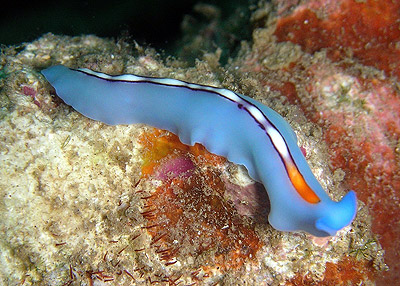
Blue Pseudoceros Flatworm,
Pseudoceros bifurcus - Turbellaria. While
many flatworms are pretty yucky or at best weirdly interesting,
some of the free living marine Turbellaria are really
quite pretty!
picture - Stephen Childs, used under
CC2 Attribution Generic License
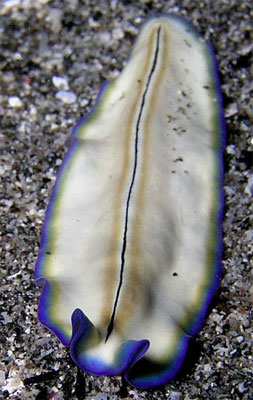
Another free living marine flatworm,
Pseudoceros monostichos - Turbellaria
picture
- Nhobgood, used under CC3 Attribution Share Alike Unported
License
Kingdom - Animalia
Phylum - Platyhelminthes
Basic Features:
The group includes:
Typically a tapeworm has a head or scolex which attaches
itself and then a series of proglottids that
are reproductive segments, they may be mistaken for
Annelids (the segmented worms) as they look superficially
segmented in the same manner. The proglottids grow towards
the end of the worm here they break off to release eggs
with the faeces of the host.
- Taenia - a genus that includes
economically important livestock parasites such
as those of pigs and cattle. It is thought that
such parasites have a part to play in pork being
a "forbidden" meat in some religions.
- Liver flukes - parasites of a wide range of vertebrates such as sheep, deer, camels and man.
- Lung and intestinal flukes - many members of this group infect the gut or connected structures of the primary host. Lungs, bile ducts, pancreatic ducts and intestines are common sites.
- Schistosoma - the cause of
Shistosomiasis or Bilharzia, the second commonest
and debilitating tropical disease after malaria.
Individuals are hermaphrodite (male and female at the same time, some larger marine species have an unusual mating behaviour called penis fencing! The loser is impregnated and takes the more energetically expensive female role of growing the eggs which hatch into planktonic larvae
What do flatworms eat?
Cestodes are all endoparasites (internal parasites), they are the most highly specialized of the flatworms. There is no digestive tract, they absorb nutrients directly across the body wall from the digestive tracts of the vertebrates that are their primary hosts, they have a surface that itself is increased in surface area to absorb nutrients just like the gut wall of their host.
They are usually caught by eating raw or uncooked contaminated fish, beef or pork.
Trematodes are almost all endoparasites. They feed on the cells, cell fragments, tissue fluids or blood of their host. They are one of the most widespread and serious groups of human parasites.
They usually have a vertebrate as the primary host and then one or maybe two intermediary hosts. The Chinese liver fluke for example has man as its primary host and then a snail and a fish as its intermediary hosts. The parasite produces cercaria larvae released by the snail and then burrow through the skin of a fish where they encyst in the muscle, they are then eaten by man where they migrate to the liver where they make eggs that are released in the faeces to be taken in by snails.
Some Trematodes such as Schistosomes are very highly adapted parasites, rarely causing death, despite being one of the greatest plagues in tropical regions. They cause weakness and suffering for many years in the human hosts. In the intermediary snail hosts, Schistosomes reach a perfect balance as a parasite. They allow the snail to live and feed but not to grow or breed, any excess food the snail takes in is diverted to the production of parasite larvae to infect humans the next step in their life cycle. Keeping the host alive and producing new parasites is a much better strategy than killing the host when the parasites would almost always die as well.
Turbellarians are predators on smaller animals, invertebrates or protozoans and scavengers.
One species known as the New Zealand Flatworm is an invasive species in Europe where it arrived in the 1960's. It eats earthworms resulting in a reduction of soil quality.
A small marine species, Symsagittifera roscoffensis (previously Convoluta roscoffensis) 15mm long and found along the Atlantic coast of Europe swallows algal cells which live as endosymbionts, it doesn't have to feed at all as an adult. The bright green colouration has earned it the name "mint sauce worm", picture banner at top of this page.
What eats flatworms?
Free living flatworms, the Turbellarians are soft bodied and slow moving, there are species that live in fresh and sea water this makes them ready prey for a whole host of fish, crustaceans, amphibia, diving beetles, and insect larvae amongst other animals that can make a meal of a small worm.
There don't seem to be any animals that are specialists in eating flatworms, probably because they are easy to catch and frequently hide so can't be relied on as a prey animal, instead they are part of the diet of many generalist and opportunist predators.
As Cestodes and Trematodes are overwhelmingly parasitic, they are the top of their foodchain.
Some gill flukes of fish may be eaten by cleaner wrasse on coral reefs, these small fish help clean up larger fish even swimming into their mouths and gills to do so, the larger fish benefit from the association and so don't try to eat the small fish that they could do easily.

The life cycle of the pork tapeworm Taenia spp. Showing
how infection can lead to Cysticercosis.
This is
when the cysticerci stage form in various tissues that can include
the brain and eyes.
Swimming free-living marine Leopard Flatworm
Schistosomiasis - a documentary by the
Wellcome Trust
Banner top of page - Symsagittifera roscoffensis in Jersey, "mint sauce worm", a free living flatworm that contains algae that it lives in symbiosis with, instead of feeding the worms seek out light to enable the algae to photsynthesize, picture Stevie Smith used under CC2 Attributio Generic license.
